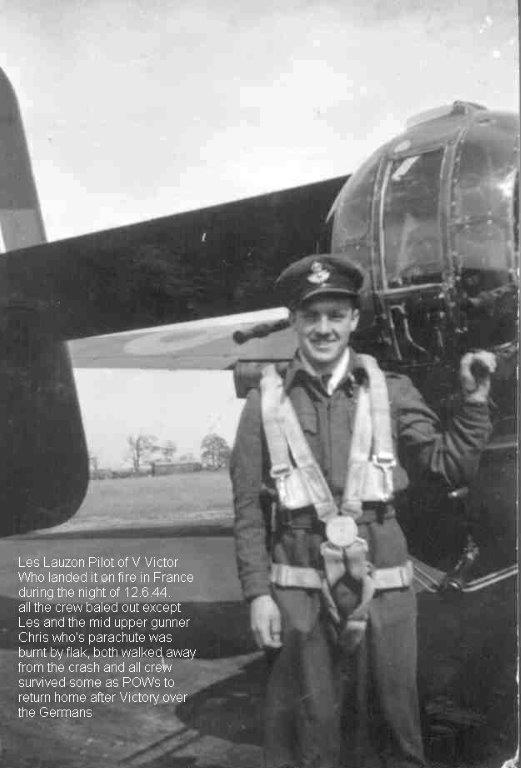Mother, Mother, I don’t want to die.
By Flying Officer Les Lauzon, 432 Squadron
The words came over my emergency radio channel as I was going down in flames on a dark night just west of Cambrai, France, on June 13th 1944. The Leaside Squadron had been assigned the marshalling yards in Cambrai as our target for the night, flying at low altitude of 6,000ft to assure accuracy and to protect the French population. Just as I was closing the bomb doors after the bombs were dropped the Halifax 111 four engine bomber was hit by two of four shells fired at the aircraft from the ground. One shell went through the mid-upper gunner’s turret and another went through the port wing between the two engines, damaging both and causing a fire. The fuel lines were cut and high octane fuel was pouring into the fuselage. I knew the aircraft was mortally wounded so immediately gave the orders for the crew to bail out. Calls from each of the crew, except the tail gunner, came back over my headset as they left and parachuted into the dark sky over enemy territory.
With two engines damaged on the port side I had tremendous difficulty in controlling the aircraft. I wrapped my left arm around the control column and trimmed the aircraft as best I could, but it required all my strength. The fire, smoke and smell of cordite filled the cockpit and I opened the escape hatch above my head. The damaged wing had to be held up otherwise the aircraft would have spun into the ground within seconds with no chance of survival. My Flight Engineer rushed by me to exit the aircraft but fortunately I was able to grab him and get him to give me my chute. A few seconds later my mid-upper gunner came up beside me – his parachute had been hit by flak and was burned. I decided the best thing to do was to give him mine, so I detached it from my Sutton Harness and gave it to him ordering him to bail out. Just below me, a few miles ahead, was a burning Lancaster crashing into the ground. I was watching the ground to see if there was any water or something that would give me an idea of my altitude. There was nothing – just darkness. I prayed and turned my radio to the emergency channel and one voice came through loud and clear “Mother, Mother. I don’t want to die. I don’t want to die” and then silence. I prayed as I tried everything to control the aircraft and to make a judgement on my altitude. To my surprise my gunner came up beside me – he had not jumped and had tried to put out the fires with the extinguishers – a hopeless job. Chris Christoff was a real hero – only 18 1/2 years old and he stayed with me, later telling me he wasn’t about to leave me alone in the aircraft. At this point I was afraid we were too low for him to bail out. Also there was the possibility of the aircraft exploding or a fighter attack to finish us off. Machine gun shells were exploding from the heat of the burning fuel. I watched the altimeter and decided at 600ft that I was near enough the ground so I closed the throttles and shut down the engines. It was a miracle – the aircraft touched down and swung 90 degrees left avoiding a raised double track electric railway line just ahead of us. I crawled out of the canopy above me and Chris followed me onto the wing and then to the ground. We were both overjoyed to still be alive but we were still in enemy territory! This was just the start of the fight to stay alive and possibly escape.

This story was sent to us by Reg Miles who lives in Maryborough, Queensland. He is 96 years old, and joined the RAF in January 1939 as an AA at Halton. He flew with RCAF as Flight Engineer, from Tholthorpe and Eastmoor on 41 ops with 432 and 420 Squadrons. He says about Les
“Les Lauzon was the cause of me not going with them on their last op, he was distracted and failed to hold the control column while I removed the elevator lock, most FEs lost some fingers when this happened, but being solid bone from head to toe, he just mangled my hand very badly. How he was distracted will best be forgotten.
So after many years of trying to contact Les or any of the crew, I managed to find that he was in an old peoples home in north Canada, on the phone from Australia I managed to battle my way past the Matron, and spoke to Les, a very faint old voice replied. When I said I was his Flight Engineer from WW2, he replied, “How is your hand?”. Tears streamed down my face, this hero had been shot down saved all his crew, been a prisoner of the Germans, got home again, married, had a family, and now, far from well, still remembered my hand, and had done so every day of his life since the 12 June 1944. It still makes me sad when I retell it again.”
For more blogs like this please click here
Our Losses Database holds over 3 million pieces of data on those who lost their lives serving and supporting Bomber Command. To find out more click here
